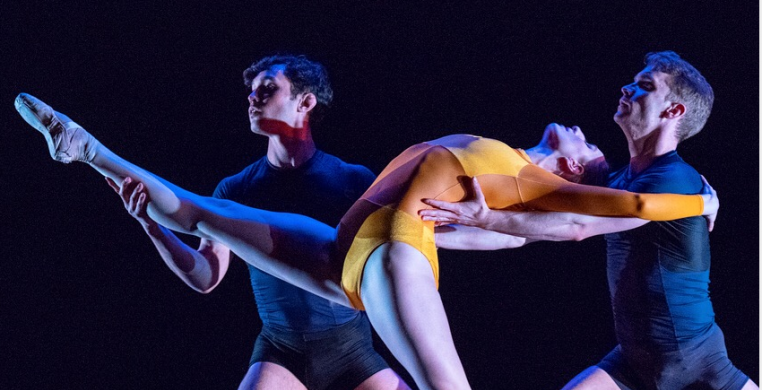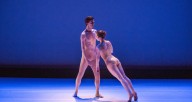Now in its 6th season, Chicago Repertory Ballet (CRB) continues to build in size and stature with a two-night engagement called “Modern Motions” at the Athenaeum Theatre. Ambitious choreography, four world premieres, and beefy production value have me sitting up a bit for this group, a once fledgling company that appears to be emerging from the pack.
Schaaf inherited dancers John Cartwright and Luis Vazquez from Thodos Dance Chicago after the mid-size company disbanded its ensemble in 2017, adding to his growing list of Thodos expats who dance and/or choreograph for CRB. Another of these is Tenley Dickey (formerly Dorill), whose “All the Things You Are” opened the second half of the program. It’s her second work for this company, having won CRB’s choreography competition in 2015 – this is another sentimental group work, set to a selection of jazz standards including “All of Me” by Billie Holiday, and the Bill Evans Trio’s “Humoresque” and “Peace Piece.” “All the Things You Are” is cute and fun, with elasticized contemporary moves and swing-inspired partnering. In the context of the other works on the program, this feels a bit superfluous, but the dance’s loosey-goosey quality is a nice break from super serious dancing. I only wish the fun had spread all the way to their faces; the men in particular forgot to smile every once in awhile.
Schaaf opened and closed the program with his own creations: last year’s “Illuminations Nos. 1-3” and a new work, “Grand Pianola Music: On the Dominant Divide.” The latter was the most balletic of the night, complete with pink tights and dance dresses for the women, and tights and waistcoats for the men (designed and constructed by Nathan Rohrer). John Adams’ mawkish score of the same name is the driving factor here; “Grand Pianola” has a zealous grandeur similar to last season’s “Symphony of Hope.” Schaaf’s sense of musicality sometimes mystifies me, and I found his interpretation of Adams’ 1981 minimalist composition equally compelling. He accents unexpected moments, carving the space in such a way that tempers what sounds to me like an unyielding wall of sound. As per usual, Schaaf asks a lot of his cast – this work is chock full of partnering, difficult pointe work, and classical tropes like fouétté turns and double tours. While this group (the majority of which is comprised of dancers specializing in contemporary dance) falls just short of meeting this high technical bar, Schaaf gets them closer to it with each passing season.
The first of three “Illuminations” opened the evening, created last fall as a collaboration between Schaaf and Laura Kariotis, the director of Nomi Dance. Here, the dancers wear shear frocks with red or black briefs (designed by Schaaf). They take turns between dancing and wielding a lighting instrument, apparently fascinated by a Parcan, panning the downstage space to create moving shadows across the scrim on the back wall. (Get it? Illuminations?)
It’s pretty apparent that the second and third sections of this work were added later, but together the trio of vignettes create an interesting juxtaposition between light and dark themes. Lighting designer Sarah Lackner asserts herself in this piece, to great effect, with striking images transforming the space and the bodies within it. When she’s “on,” Lackner is very, very good.
As is multi-faceted Schaaf, whose best costume creations of the evening were those for Hubbard Street alum Shannon Alvis. With another piece by Ryan Jolicoeur-Nye, of Kansas City Ballet, these rounded out the program with two more world premieres. Schaaf's beautiful brown frocks in Shannon Alvis’ “Trees, Melody” support Alvis’ aesthetic, which positions the women as drippy, malleable creatures, manipulable by their male partners. Despite some truly breathtaking moments, this is something I find frustrating in Alvis’ work.
In Nye’s “Closing,” costumer Nathan Rohrer dresses the women in striking canary-hued leotards, a sleek and powerful look for five ladies providing a much-needed punch for this work.Their counterparts wear dark tops and shorts, and the music is Philip Glass and Max Richter (my feelings about which I’ve alluded to here and here (Cliff’s notes: overplayed)). That said, employing Glass and his post-minimalist predecessors in dance challenges choreographers to create arcs with movement. Crescendos and decrescendos of this style of music inevitably lead listeners in circles. One could choose to stay there (which, in my view, leads to an unremarkable dance), or bust out from the monotony of its monophonic loops. My sense with “Closing” is that it’s a mixture of these two approaches, neither dictated by nor completely ignoring the music. For me, that’s what kept it interesting.
Lauren Warnecke is the dance writer and critic at the Chicago Tribune.


